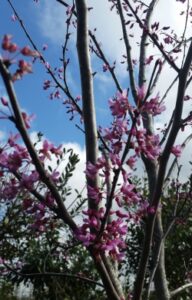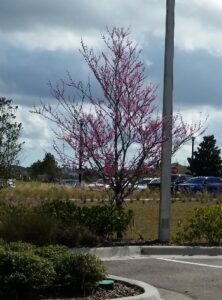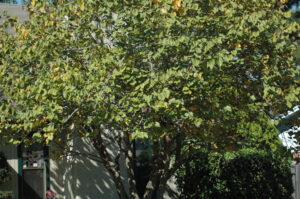S & J Nursery’s Guide to Growing
Eastern Redbud
in the Northeast Florida Landscape
( Cercis Canadensis )
Redbud Origins:
– Eastern Redbud trees are native to the eastern United States.
Redbud Preferred Exposure:
– Full sun to light shade
Redbud Foliage | Bark:
– Redbuds have characteristic heart shaped leaves that start out a deep purple color and mature to a dark purplish toned green.
– Redbuds foliage is deciduous, although unreliable from year to year in the North Florida | Jacksonville | St. Augustine landscape, Redbud foliage will turn a showy yellow color before falling off the tree for the winter when weather conditions are right.
– The bark of the Redbud tree is a dark purplish brown color.
Eastern Redbud Soil Preference / Salt tolerance:
– Eastern Redbud trees are not particular and will tolerate a wide range of soil components and conditions form dry to wet and acid to alkaline.
– Eastern Redbud trees are not salt tolerant.
 Eastern Redbud Trees Size Variance:
Eastern Redbud Trees Size Variance:
– can reach sizes of 20-35 feet H | 15-25 feet W depending on how many trunks are allowed to develop.
Redbud Growth Habit:
– Redbud trees will tend to have an upright vase shaped branch structure with a flat to rounded top.
Redbud Growth Rate:
– Eastern Redbuds area fast growing but short lived tree.
Redbud Bloom:
– Eastern redbud trees cover their branches with small sweat pea shaped blossoms that are pinkish purple in color before acquiring their new leaves each year in the spring.
– One of the few native flowering trees for our area and truly a beautiful spring display.
Redbud Water Requirements:
– Redbuds will require good water during the establishment period and supplemental irrigation when planted in well draining soils during dry spells during its first few years in the
landscape.
Butterfly or Bird Attracting:
– Birds will eat the seeds of the Redbud tree that hang on the branches in long brown pods.
Best Uses For Redbud :
– Perhaps my favorite use for a Red bud tree is planted along the edge of an
otherwise untouched forest area that borders a landscaped property, who said leaving well enough alone is preferable to…. just.. a bit of tweaking? Redbud trees blend seamlessly into naturalized settings along the edge of nature preserves or woodland areas adding a splash of color on an otherwise always green forest backdrop each spring when in bloom.
– Redbuds also make a great smaller scale ornamental tree for spring
color.
Care of Redbud:
– Water every day during the establishment period. See watering your newly planted trees for more information.
-Eastern Redbud trees will need good water during the establishment period and supplemental irrigation during dry spells or particularly hot dry summers for the first few years after planting.
– Redbud trees are unacceptable to limb damage and will need proper pruning. Prune dead or weakened branches as needed taking particular care to remove any branches with a ‘v’ shaped union to the trunk and keeping only one branch with a ‘u’ shaped union every 6-10 inches along the trunk.
– Provide a 1 ft diameter circle of mulched area where grass is kept from growing for each inch of caliper (or diameter) of trunk measured 4 inches from the ground level.
– Fertilize each spring with a mixture of Milorganite and a slow release poly coated plant food such as Osmocote or Stay Green general purpose plant food, sprinkling the fertilizer around the mulch circle underneath the foliage of the tree.

